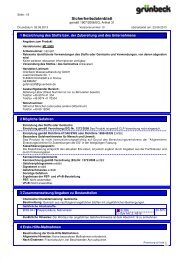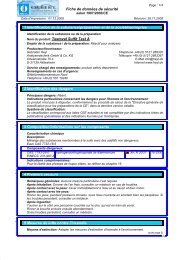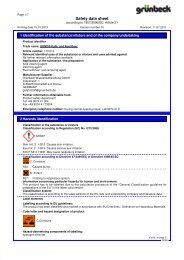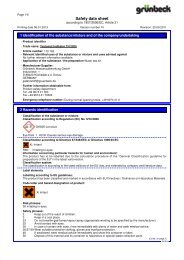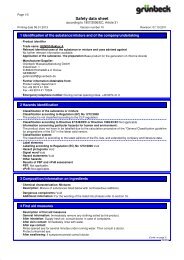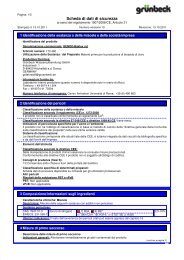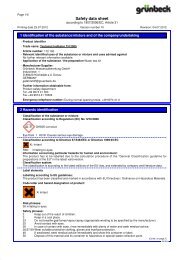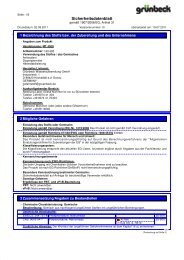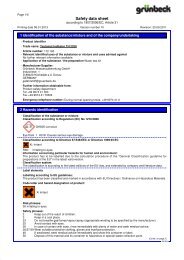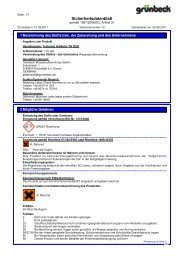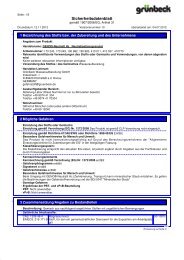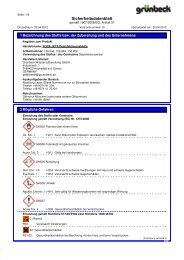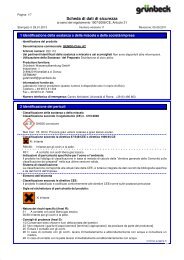SDB GENO-phos Nr 1 GB - Grünbeck Wasseraufbereitung GmbH
SDB GENO-phos Nr 1 GB - Grünbeck Wasseraufbereitung GmbH
SDB GENO-phos Nr 1 GB - Grünbeck Wasseraufbereitung GmbH
You also want an ePaper? Increase the reach of your titles
YUMPU automatically turns print PDFs into web optimized ePapers that Google loves.
35.0.2<br />
Page 1/6<br />
Safety data sheet<br />
according to 1907/2006/EC, Article 31<br />
Printing date 22.06.2012 Version number 11<br />
Revision: 31.08.2011<br />
1 Identification of the substance/mixture and of the company/undertaking<br />
· Product identifier<br />
· Trade name: <strong>GENO</strong>®-<strong>phos</strong> <strong>Nr</strong>. 1<br />
· Article number: 170 001, 170 002, 170 052<br />
· CAS Number:<br />
10101-89-0<br />
· Application of the substance / the preparation Precipitation of residual hardness and alcalinisation<br />
· Manufacturer/Supplier:<br />
<strong>Grünbeck</strong> <strong>Wasseraufbereitung</strong> <strong>GmbH</strong><br />
Industriestr. 1<br />
D-89420 Höchstädt a.d. Donau<br />
GERMANY<br />
gefahrstoff@gruenbeck.de<br />
· Further information obtainable from: Product safety department<br />
· Emergency telephone number: During normal opening times: +49 9074 41-0<br />
* 2 Hazards identification<br />
· Classification of the substance or mixture<br />
· Classification according to Regulation (EC) No 1272/2008<br />
GHS07<br />
Skin Irrit. 2 H315 Causes skin irritation.<br />
Eye Irrit. 2 H319 Causes serious eye irritation.<br />
STOT SE 3 H335 May cause respiratory irritation.<br />
· Classification according to Directive 67/548/EEC or Directive 1999/45/EC<br />
Xi; Irritant<br />
R36/37/38: Irritating to eyes, respiratory system and skin.<br />
· Information concerning particular hazards for human and environment: Not applicable.<br />
· Label elements<br />
· Labelling according to Regulation (EC) No 1272/2008<br />
The substance is classified and labelled according to the CLP regulation.<br />
· Hazard pictograms<br />
GHS07<br />
· Signal word Warning<br />
· Hazard statements<br />
H315 Causes skin irritation.<br />
H319 Causes serious eye irritation.<br />
H335 May cause respiratory irritation.<br />
· Precautionary statements<br />
P261 Avoid breathing dust/fume/gas/mist/vapours/spray.<br />
P280 Wear protective gloves/protective clothing/eye protection/face protection.<br />
P305+P351+P338 IF IN EYES: Rinse cautiously with water for several minutes. Remove contact lenses, if present<br />
and easy to do. Continue rinsing.<br />
P362 Take off contaminated clothing and wash before reuse.<br />
P304+P340 IF INHALED: Remove victim to fresh air and keep at rest in a position comfortable for breathing.<br />
P312 Call a POISON CENTER or doctor/physician if you feel unwell.<br />
P405 Store locked up.<br />
P501 Dispose of contents/container in accordance with local/regional/national/international<br />
regulations.<br />
(Contd. on page 2)<br />
<strong>GB</strong>
35.0.2<br />
Page 2/6<br />
Safety data sheet<br />
according to 1907/2006/EC, Article 31<br />
Printing date 22.06.2012 Version number 11<br />
Revision: 31.08.2011<br />
Trade name: <strong>GENO</strong>®-<strong>phos</strong> <strong>Nr</strong>. 1<br />
· Other hazards<br />
· Results of PBT and vPvB assessment<br />
· PBT: Not applicable.<br />
· vPvB: Not applicable.<br />
3 Composition/information on ingredients<br />
· Chemical characterization: Substances<br />
· CAS No. Description<br />
10101-89-0 Trinatriummono<strong>phos</strong>phat-12-Hydrat<br />
4 First aid measures<br />
· Description of first aid measures<br />
· After inhalation: In case of unconsciousness place patient stably in side position for transportation.<br />
· After skin contact:<br />
If skin irritation continues, consult a doctor.<br />
Immediately wash with water and soap and rinse thoroughly.<br />
· After eye contact:<br />
Rinse opened eye for several minutes under running water. If symptoms persist, consult a doctor.<br />
· After swallowing: Rinse out mouth and then drink plenty of water.<br />
· Information for doctor:<br />
· Most important symptoms and effects, both acute and delayed No further relevant information available.<br />
· Indication of any immediate medical attention and special treatment needed<br />
No further relevant information available.<br />
5 Firefighting measures<br />
· Extinguishing media<br />
· Suitable extinguishing agents:<br />
CO2, powder or water spray. Fight larger fires with water spray or alcohol resistant foam.<br />
· Special hazards arising from the substance or mixture No further relevant information available.<br />
· Advice for firefighters<br />
· Protective equipment: No special measures required.<br />
6 Accidental release measures<br />
· Personal precautions, protective equipment and emergency procedures Wear protective clothing.<br />
· Environmental precautions: Do not allow to enter sewers/ surface or ground water.<br />
· Methods and material for containment and cleaning up: Ensure adequate ventilation.<br />
· Reference to other sections<br />
See Section 7 for information on safe handling.<br />
See Section 8 for information on personal protection equipment.<br />
See Section 13 for disposal information.<br />
7 Handling and storage<br />
· Handling:<br />
· Precautions for safe handling Prevent formation of dust.<br />
· Information about fire - and explosion protection: The product is not flammable.<br />
· Conditions for safe storage, including any incompatibilities<br />
· Storage:<br />
· Requirements to be met by storerooms and receptacles:<br />
Store only in the original receptacle.<br />
Do not use light alloy receptacles.<br />
· Information about storage in one common storage facility: Do not store together with acids.<br />
· Further information about storage conditions:<br />
Protect from humidity and water.<br />
Store in dry conditions.<br />
(Contd. of page 1)<br />
(Contd. on page 3)<br />
<strong>GB</strong>
35.0.2<br />
Page 3/6<br />
Safety data sheet<br />
according to 1907/2006/EC, Article 31<br />
Printing date 22.06.2012 Version number 11<br />
Revision: 31.08.2011<br />
Trade name: <strong>GENO</strong>®-<strong>phos</strong> <strong>Nr</strong>. 1<br />
Keep container tightly sealed.<br />
· Storage class: 13 - Non-combustible solids<br />
· Specific end use(s) No further relevant information available.<br />
8 Exposure controls/personal protection<br />
· Additional information about design of technical facilities: No further data; see item 7.<br />
· Control parameters<br />
· Ingredients with limit values that require monitoring at the workplace: Not required.<br />
· Additional information: The lists valid during the making were used as basis.<br />
(Contd. of page 2)<br />
· Exposure controls<br />
· Personal protective equipment:<br />
· General protective and hygienic measures:<br />
Keep away from foodstuffs, beverages and feed.<br />
Immediately remove all soiled and contaminated clothing<br />
Wash hands before breaks and at the end of work.<br />
Avoid contact with the eyes and skin.<br />
· Respiratory protection:<br />
Short term filter device:<br />
Filter P1<br />
In case of brief exposure or low pollution use respiratory filter device. In case of intensive or longer exposure use<br />
self-contained respiratory protective device.<br />
· Protection of hands:<br />
Protective gloves<br />
The glove material has to be impermeable and resistant to the product/ the substance/ the preparation.<br />
Due to missing tests no recommendation to the glove material can be given for the product/ the preparation/ the<br />
chemical mixture.<br />
Selection of the glove material on consideration of the penetration times, rates of diffusion and the degradation<br />
· Material of gloves<br />
Butyl rubber, BR<br />
Nitrile rubber, NBR<br />
Rubber gloves<br />
Neoprene gloves<br />
The selection of the suitable gloves does not only depend on the material, but also on further marks of quality and<br />
varies from manufacturer to manufacturer.<br />
· Penetration time of glove material<br />
The exact break through time has to be found out by the manufacturer of the protective gloves and has to be<br />
observed.<br />
· Eye protection:<br />
Tightly sealed goggles<br />
9 Physical and chemical properties<br />
· Information on basic physical and chemical properties<br />
· General Information<br />
· Appearance:<br />
Form: Crystalline powder<br />
Colour: White<br />
· Odour: Odourless<br />
· pH-value (10 g/l) at 20°C: 12<br />
· Change in condition<br />
Melting point/Melting range: 75°C<br />
(Contd. on page 4)<br />
<strong>GB</strong>
35.0.2<br />
Page 4/6<br />
Safety data sheet<br />
according to 1907/2006/EC, Article 31<br />
Printing date 22.06.2012 Version number 11<br />
Revision: 31.08.2011<br />
Trade name: <strong>GENO</strong>®-<strong>phos</strong> <strong>Nr</strong>. 1<br />
Boiling point/Boiling range: Undetermined.<br />
· Flash point: Not applicable.<br />
· Flammability (solid, gaseous): Product is not flammable.<br />
· Danger of explosion: Product does not present an explosion hazard.<br />
· Density: n.a.<br />
· Bulk density at 20°C: ca. 900 kg/m³<br />
· Solubility in / Miscibility with<br />
water at 20°C: 140 g/l<br />
Organic solvents: 0.0 %<br />
Solids content: 100.0 %<br />
· Other information No further relevant information available.<br />
10 Stability and reactivity<br />
· Reactivity<br />
· Chemical stability<br />
· Thermal decomposition / conditions to be avoided: No decomposition if used according to specifications.<br />
· Possibility of hazardous reactions Reacts with light alloys in the presence of moisture to form hydrogen.<br />
· Conditions to avoid No further relevant information available.<br />
· Incompatible materials: No further relevant information available.<br />
11 Toxicological information<br />
· Information on toxicological effects<br />
· Acute toxicity:<br />
· LD/LC50 values relevant for classification:<br />
10101-89-0 Trinatriummono<strong>phos</strong>phat-12-Hydrat<br />
Oral LD50 > 2000 mg/kg (rat)<br />
· Primary irritant effect:<br />
· on the skin: Irritant to skin and mucous membranes.<br />
· on the eye: Irritating effect.<br />
· Sensitization: No sensitizing effects known.<br />
12 Ecological information<br />
(Contd. of page 3)<br />
· Toxicity<br />
· Aquatic toxicity:<br />
10101-89-0 Trinatriummono<strong>phos</strong>phat-12-Hydrat<br />
Oral LCO/48h 2400 mg/l (orfe)<br />
· Persistence and degradability No further relevant information available.<br />
· Behaviour in environmental systems:<br />
· Bioaccumulative potential No further relevant information available.<br />
· Mobility in soil No further relevant information available.<br />
· Additional ecological information:<br />
· General notes:<br />
Water hazard class 1 (German Regulation) (Self-assessment): slightly hazardous for water<br />
Do not allow undiluted product or large quantities of it to reach ground water, water course or sewage system.<br />
Rinse off of bigger amounts into drains or the aquatic environment may lead to increased pH-values. A high pHvalue<br />
harms aquatic organisms. In the dilution of the use-level the pH-value is considerably reduced, so that after<br />
the use of the product the aqueous waste, emptied into drains, is only low water-dangerous.<br />
· Results of PBT and vPvB assessment<br />
· PBT: Not applicable.<br />
· vPvB: Not applicable.<br />
(Contd. on page 5)<br />
<strong>GB</strong>
35.0.2<br />
Page 5/6<br />
Safety data sheet<br />
according to 1907/2006/EC, Article 31<br />
Printing date 22.06.2012 Version number 11<br />
Revision: 31.08.2011<br />
Trade name: <strong>GENO</strong>®-<strong>phos</strong> <strong>Nr</strong>. 1<br />
· Other adverse effects No further relevant information available.<br />
* 13 Disposal considerations<br />
· Waste treatment methods<br />
· Recommendation<br />
Must not be disposed together with household garbage. Do not allow product to reach sewage system.<br />
· Uncleaned packaging:<br />
· Recommendation:<br />
Disposal must be made according to official regulations.<br />
Empty contaminated packagings thoroughly. They may be recycled after thorough and proper cleaning.<br />
Packagings that may not be cleansed are to be disposed of in the same manner as the product.<br />
* 14 Transport information<br />
· UN-Number<br />
· ADR, ADN, IMDG, IATA Void<br />
· UN proper shipping name<br />
· ADR, ADN, IMDG, IATA Void<br />
· Transport hazard class(es)<br />
· ADR, ADN, IMDG, IATA<br />
· Class Void<br />
· Packing group<br />
· ADR, IMDG, IATA Void<br />
· Environmental hazards:<br />
· Marine pollutant: No<br />
· Special precautions for user Not applicable.<br />
· Transport in bulk according to Annex II of<br />
MARPOL73/78 and the IBC Code Not applicable.<br />
· UN "Model Regulation": -<br />
* 15 Regulatory information<br />
· Safety, health and environmental regulations/legislation specific for the substance or mixture<br />
· Labelling according to Regulation (EC) No 1272/2008<br />
The substance is classified and labelled according to the CLP regulation.<br />
· Hazard pictograms<br />
GHS07<br />
(Contd. of page 4)<br />
· Signal word Warning<br />
· Hazard statements<br />
H315 Causes skin irritation.<br />
H319 Causes serious eye irritation.<br />
H335 May cause respiratory irritation.<br />
· Precautionary statements<br />
P261 Avoid breathing dust/fume/gas/mist/vapours/spray.<br />
P280 Wear protective gloves/protective clothing/eye protection/face protection.<br />
P305+P351+P338 IF IN EYES: Rinse cautiously with water for several minutes. Remove contact lenses, if present<br />
and easy to do. Continue rinsing.<br />
P362 Take off contaminated clothing and wash before reuse.<br />
P304+P340 IF INHALED: Remove victim to fresh air and keep at rest in a position comfortable for breathing.<br />
P312 Call a POISON CENTER or doctor/physician if you feel unwell.<br />
(Contd. on page 6)<br />
<strong>GB</strong>
35.0.2<br />
Page 6/6<br />
Safety data sheet<br />
according to 1907/2006/EC, Article 31<br />
Printing date 22.06.2012 Version number 11<br />
Revision: 31.08.2011<br />
Trade name: <strong>GENO</strong>®-<strong>phos</strong> <strong>Nr</strong>. 1<br />
(Contd. of page 5)<br />
P405 Store locked up.<br />
P501 Dispose of contents/container in accordance with local/regional/national/international<br />
regulations.<br />
· Chemical safety assessment: A Chemical Safety Assessment has not been carried out.<br />
16 Other information<br />
This information is based on our present knowledge. However, this shall not constitute a guarantee for any specific<br />
product features and shall not establish a legally valid contractual relationship.<br />
· Department issuing MSDS: Laboratory<br />
· Contact: Mrs. Gerstmeier<br />
· Abbreviations and acronyms:<br />
RID: Règlement international concernant le transport des marchandises dangereuses par chemin de fer (Regulations Concerning the International<br />
Transport of Dangerous Goods by Rail)<br />
ICAO: International Civil Aviation Organization<br />
ADR: Accord européen sur le transport des marchandises dangereuses par Route (European Agreement concerning the International Carriage of<br />
Dangerous Goods by Road)<br />
IMDG: International Maritime Code for Dangerous Goods<br />
IATA: International Air Transport Association<br />
GHS: Globally Harmonized System of Classification and Labelling of Chemicals<br />
CAS: Chemical Abstracts Service (division of the American Chemical Society)<br />
LC50: Lethal concentration, 50 percent<br />
LD50: Lethal dose, 50 percent<br />
· * Data compared to the previous version altered.<br />
<strong>GB</strong>



